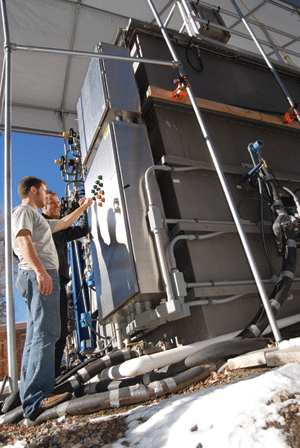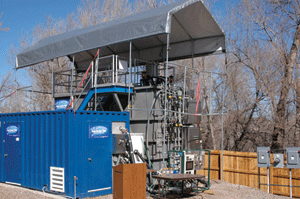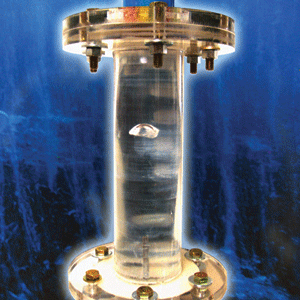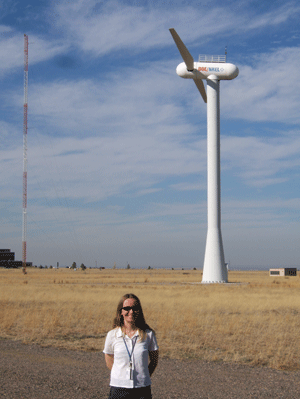 Jorg Drewes was talking about water quality, a favorite topic, when the Mines Park student housing sprinklers kicked on just uphill. As artificial rain fell onto July bluegrass, he observed: “They’re wasting pure drinking water.”
Jorg Drewes was talking about water quality, a favorite topic, when the Mines Park student housing sprinklers kicked on just uphill. As artificial rain fell onto July bluegrass, he observed: “They’re wasting pure drinking water.”
Drewes, an associate professor of environmental science and engineering, dedicates much of his intellectual energy to avoiding precisely such waste. It happened that he was standing next to a pilot system already capable, with the addition of a bit of plumbing, of substituting such squandered drinking water with purified wastewater from the Mines Park housing complex itself.
The system, a sequencing batch membrane bioreactor provided by Aqua-Aerobic Systems, has been up and running since February – one of several initiatives under way at Mines’ Advanced Water Technology Center, or AQWATEC, which Drewes heads up.
It works like this: Mines Park sewage is diverted into a 2,500-gallon holding tank, where it is ground up and pumped to the 1.5-story bioreactor. Here sewage flows through a 2-millimeter filter screen and into one of two 7,000-gallon bioreactor tanks. While traditional sewage treatment sends wastewater through a series of tanks – some oxygen starved, some oxygen rich, some in between – triggering different eating habits among the invisible horde of microbes, AQWATEC’s sequencing batch reactor simply alters the conditions in the same tank.
The system’s membrane bioreactor filter is the final stage. Two hollow-fiber membrane cassettes do the filtering, each containing nine bundles of spaghetti-like strands. Every strand is pocked with 50-nanometer-wide pores too small for most microbes or viruses to get through.
“I wouldn’t drink this, no,” admitted Rick Huggins, a doctoral student whose work optimizing and assessing the economics of the system will one day inform his dissertation. The bottle of filtered water he was holding had a faintly yellow tinge. Still, the Mines system exceeds the performance of many conventional wastewater treatment plants, particularly at removing organic carbon, as well as nitrogen and phosphorous compounds – all without the use of the chemicals typically used in wastewater treatment.
And producing drinking water isn’t the objective. It’s a modular technology that enables decentralized wastewater treatment through microbial action and filtration, producing water pure enough for sprinklers, crop irrigation, or release into streams and rivers.
 The demonstration project aims to advance the technology to the point that it no longer requires the attention of doctoral students to maximize the system’s efficiency, making it as close to “plug-and-play” as possible. Anything less and risk-averse water managers will shy away, Drewes said.
The demonstration project aims to advance the technology to the point that it no longer requires the attention of doctoral students to maximize the system’s efficiency, making it as close to “plug-and-play” as possible. Anything less and risk-averse water managers will shy away, Drewes said.
Next steps include rerouting some of the system’s outflow to a sprinkler system and converting an adjacent Residence Life storage facility into a water-reuse field laboratory.
Once the lab is completed, the AQWATEC team will experiment with systems that can filter the effluent to drinkability, while testing advanced oxidation processes.
In addition to domestic wastewater treatment, AQWATEC is developing technologies that make use of water resources such as seawater, industrial effluent, and water extracted with oil and gas production.
Ultimately, every drop of wastewater reused on a field or in a drinking glass relieves the pressure on natural systems upon which we all depend. As said by Tzahi Cath, AQWATEC’s associate director and one of Drewes’ fellow faculty members: “In our work, there’s always a link from the bench to real life.”





